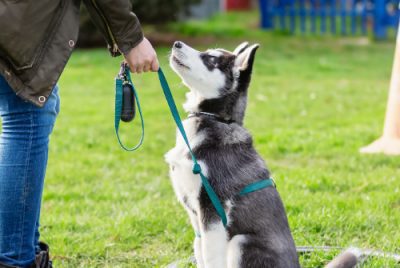Deciphering Dog Body Language: Understanding Signs & Signals
Post Disclaimer
We may earn a commission for purchases made using our links. Please see our Disclaimer to learn more.
Understanding Dog Body Language: Decoding Signs and Signals
Dogs are our loyal companions, and we love them for their boundless affection and playful antics. However, sometimes it can be hard to understand what they are trying to communicate with us. This is why understanding dog body language is crucial for all dog owners. In this blog post, we will go beyond verbal communication signals and delve into the world of non-verbal cues that dogs use to convey their emotions. From recognizing calming and fear indicators in dogs to decoding specific body language indicators like ear placement and positioning, we’ve got you covered. We’ll also talk about the role of barks in dog communication and explain what different types of barks mean. So, the next time your furry friend wags its tail or communicates with you in a certain way, you will have a better understanding of what they are trying to tell you. After all, a better understanding of dog language leads to happier dogs and happier humans!
The Importance of Understanding Dog Body Language
To truly understand our furry friends, it is essential to grasp the intricacies of their communication. This is where understanding dog body language becomes paramount. Dogs have a unique way of expressing themselves, utilizing various signals such as body posture and facial expressions to convey their emotions. By decoding these signals, we can effectively communicate with our canine companions and build a strong bond based on mutual understanding.
Recognizing and responding to their body language can prevent misunderstandings and potential conflicts. It allows us to understand their needs, ensuring their comfort and addressing any potential issues promptly. Whether it’s a wagging tail indicating excitement or growls signaling aggression, being observant of their whole body can help us decipher their intentions and respond accordingly.
For instance, a dog may exhibit anxious behavior through whining, yawning, or displaying the ‘whale eye’ (when the whites of their eyes are visible), which can be a sign of fear. These signs of fear or arousal should be taken seriously to create a safe and positive environment for our furry friends. On the other hand, a relaxed position, a relaxed front end, and a wagging tail held at a neutral height can indicate a happy and relaxed dog.
Understanding dog body language goes beyond just enhancing our communication skills—it also fosters responsible pet ownership. By being attuned to their non-verbal cues, we can better advocate for their needs, ensure their well-being, and establish ourselves as their best friends and trusted companions.
How Dogs Communicate: Beyond Verbal Signals
When it comes to understanding dogs, it’s important to go beyond their barks and vocalizations. Dogs have a rich and complex communication system that goes beyond verbal signals. They use their body language to convey a wide range of emotions and messages.
One key form of dog communication is through their tail wagging, eye contact, and facial expressions. A wagging tail can indicate happiness and excitement, including excited dogs, while direct eye contact may be a sign of assertiveness or dominance. By paying attention to these signals, you can better understand what your dog is trying to communicate.
In addition to tail wagging and eye contact, dogs also use specific postures and movements to convey their emotions. They may raise their hackles, lower their body position, or hold their ears in a certain way to indicate fear, aggression, or submission. Understanding these non-verbal cues can help you accurately interpret your dog’s emotional state.
By familiarizing yourself with your dog’s body language, you can develop a deeper connection with them and respond appropriately to their needs. Whether it’s recognizing signs of fear or excitement, understanding your dog’s body language, including canine communication, allows you to better communicate and build a strong bond with your furry friend.
Recognizing Calming and Fear Indicators in Dogs
Dogs have their unique way of communicating, and understanding their body language is essential for building a strong bond. When it comes to recognizing calming and fear indicators in dogs, there are specific signals that you should pay attention to. Calming signals, such as lip licking, yawning, or turning their head away, can indicate stress or appeasement. On the other hand, fear indicators may include trembling, growling, or cowering. By being aware of these signals, you can respond appropriately and provide comfort to your canine companion without giving in to their whines.
It’s important to acknowledge your dog’s fear and offer reassurance in challenging situations, including situations that may affect your dog’s ears. This can help them feel more secure and confident. Remember, dogs use their entire body to communicate, so pay attention to their body position, tail position, and even their ears. By understanding these indicators, you can better understand your dog’s emotions and needs. This knowledge can also help prevent potential conflicts or aggressive behavior.
As a responsible dog owner, it’s crucial to be familiar with your dog’s breed-specific body language and any individual quirks they may have, including your dog’s breed. This will enable you to interpret their communication more accurately and ensure their well-being. So, the next time you notice your dog exhibiting calming or fear indicators, take the time to understand what their body language is telling you and respond with care and compassion.
Tips for Working with a Fearful Dog
Approaching fearful dogs requires caution and an understanding of their boundaries. It’s crucial to use positive reinforcement methods to build trust and confidence in these anxious pups. Rather than forcing them into uncomfortable situations, it’s important to give them the time they need to adjust and feel safe. Gradually exposing them to fearful stimuli in a controlled and secure environment can help them overcome their fears. One common sign of anxiety in dogs is a yawn, so it’s important to watch for this behavior and adjust your approach accordingly.
When working with a fearful dog, consulting a professional dog trainer or behaviorist, such as a vet, can provide valuable guidance and support. These experts have the knowledge and experience to assess the dog’s behavior and create a tailored training plan. They can help identify triggers, develop desensitization techniques, and teach effective coping mechanisms.
Remember, every dog is unique, and their response to fear may vary, including changes in urination. By respecting their boundaries, using positive reinforcement, and seeking professional help if needed, you can create a safe and supportive environment for your fearful dog to thrive. Understanding a dog’s body language, signaling, and responding appropriately can go a long way in helping them overcome their fears and live happy, fulfilling lives.
Play and Relaxed Signals: What Does Your Dog Want to Say?

Dogs communicate their desire for play and relaxation through various signals. Play bows, excited body language, and wagging tails indicate a playful dog, while a relaxed dog has a loose body posture, floppy ears, and a neutral tail wag. Understanding these signals helps create positive interactions with your dog.
Can Tail Wagging Always Be Associated with Happiness?
Tail wagging in dogs can indicate a range of emotions, not just happiness. A high and stiff wagging tail may signal alertness or potential aggression, while a low and slow wagging tail can indicate fear or anxiety. It’s important to consider other body language cues to accurately understand your dog’s intentions.
Alert Signals: When Your Dog is Trying to Warn You
While dogs are unable to communicate with words, they have their own unique way of expressing themselves through alert signals. These signals serve as a form of communication to warn us about potential threats or dangers. Understanding and interpreting these signals is crucial for our own safety as well as the well-being of our furry friends.
One of the most common alert signals is when a dog raises its fur. This can indicate heightened vigilance and a potential threat in the surroundings. Alongside raised fur, dogs may also exhibit barking and a forward posture, both of which are signs that they are on high alert.
Another indicator of an alert dog is dilated pupils and a fixed stare. This can signify that the dog perceives a threat and is preparing to defend itself or its territory. By recognizing and acknowledging these warning signals, we can better assess the situation and respond accordingly, keeping ourselves and our beloved pets safe.
It is important to remember that understanding dog body language goes beyond just these alert signals. Dogs have their unique ways of communicating through their entire body, including their tail position, ear placement, and overall body posture. By familiarizing ourselves with these cues, we can establish a stronger bond with our canine companions and ensure their comfort and well-being.
Decoding Specific Dog Body Language Indicators
When it comes to understanding dogs, their body language can provide valuable insights into their emotions and intentions. Decoding specific dog body language indicators is essential for effective communication and decision-making. By interpreting ear placement and positioning, we can gain insights into a dog’s emotional state. The position of their ears can indicate whether they are relaxed, alert, or fearful. General body posture, including the position of their tail and stance, also plays a crucial role in understanding a dog’s intentions. A wagging tail doesn’t always mean happiness; its position and speed reveal different emotions.
It’s important to note that these indicators can vary based on the dog’s breed, size, and individual characteristics. Different breeds have their own unique set of body language cues, making it essential to consider these factors when deciphering their signals. Recognizing and understanding these specific body language indicators allow us to respond appropriately to our dog’s needs. By observing their body position, tail movement, and ear placement, we can better comprehend their emotions and intentions.
In conclusion, decoding specific dog body language indicators is key to effective communication with our furry friends. It allows us to understand their emotional state, intentions, and needs. By paying close attention to their body language, we can build a stronger bond with our dogs and ensure their well-being.
Interpreting Ear Placement and Positioning
Now let’s dive into the fascinating world of dog body language by focusing on ear placement and positioning. Dogs have a unique way of communicating their emotions through their ears. By understanding the subtle cues they give, we can gain valuable insights into their emotional state.
One of the key indicators is the position of a dog’s ears. When a dog’s ears are erect, it usually signifies attentiveness or alertness. It’s their way of saying, “I’m paying attention to the world around me.” On the other hand, drooping or partially flattened ears suggest relaxation or submission. It’s a sign that the dog feels safe and at ease in their environment.
However, if you notice a dog with pinned-back ears, it may indicate fear, anxiety, or even aggression. It’s crucial to recognize this as a warning sign and approach the dog with caution. Understanding the nuances of ear placement is essential for accurately interpreting a dog’s emotional state and responding accordingly.
By paying attention to these subtle signals, you can strengthen your bond with your four-legged companion and improve communication. Remember, dogs have their unique language, and being able to understand and respond to their cues is key to nurturing a harmonious relationship. So, the next time you interact with a dog, keep an eye on their ear placement and positioning – it will speak volumes about how they’re feeling.
Understanding General Body Posture in Dogs
Understanding the general body posture of dogs is key to deciphering their emotional state. Just by observing their overall body language, you can gain valuable insights into whether a dog is relaxed or displaying aggression. A relaxed dog will have a loose and wiggly body, indicating that they are calm and at ease. On the other hand, a dog with a stiff and upright posture may be showing signs of aggression or discomfort. By understanding these general body postures, you can assess their level of comfort and provide the necessary support.
Recognizing and responding to a dog’s body language is essential in creating a supportive and caring environment for them. It allows you to gauge their emotional well-being and address any issues they may be facing. Whether it’s through their body position, tail position, or stance, dogs communicate their feelings and intentions non-verbally. Being attuned to their body language helps you establish a stronger connection with your furry friend and fosters effective communication.
So, the next time your dog exhibits a certain body posture, pay attention to their whole body, including their ears, tail, and even their breath. It’s all part of their intricate system of communication. By understanding and responding to their body language, you can better understand your dog and create a comfortable and harmonious environment for them.
The Role of Barks in Dog Communication
Barks play a crucial role in dog communication, conveying various messages and emotions. Different types of barks can indicate different needs or warnings, allowing dogs to express excitement, fear, aggression, or playfulness. Understanding your dog’s barks is essential for responding appropriately to their needs. However, it’s important to pay attention to the context and accompanying body language when interpreting barks.
When your dog barks, consider the situation and their overall body language. Are they exhibiting any signs of fear or aggression? Are they displaying a relaxed or tense body position? By taking these cues into account, you can better understand what your dog is trying to communicate. For example, if your dog barks while wagging their tail and jumping with excitement, it could be a sign of playfulness. On the other hand, if they bark with an aggressive body language, such as front paw raised or piloerection (raised fur), it may indicate a potential threat.
Remember, dogs rely on barks as part of their broader communication system. By being attentive to their barks and understanding the context, you can better respond to their needs and strengthen your bond with your furry friend.
What Do Different Types of Barks Mean?
Different types of barks in dogs can convey various meanings. A high-pitched bark may indicate excitement or eagerness, while a low, deep bark could signal perceived threat or aggression. Rapid, repetitive barking may be a sign of anxiety or frustration. Growling accompanied by barks often serves as a warning or display of aggression. Additionally, barks combined with a wagging tail and relaxed body posture usually indicate a happy and playful dog.
How Well Do You Know Your Dog’s Body Language?
Understanding your dog’s body language is crucial for effective communication. Happy dogs exhibit signs like a wagging tail, relaxed posture, and soft eyes. Conversely, stress or anxiety may manifest as panting, pacing, or avoiding eye contact. Learning to interpret these signals strengthens your bond and prevents misunderstandings.
Advocacy for Better Understanding of Dog Language.
Advocating for a better understanding of dog language is key to fostering healthy relationships between humans and dogs. Dogs possess their own unique way of communicating with both their human counterparts and fellow canines. By familiarizing ourselves with the intricacies of dog body language, we can effectively prevent unwanted behaviors, minimize the risk of bites and mishaps, and deepen the bond with our furry companions.
Tail wagging, ear position, and eye contact are just a few examples of common signs that dogs use to express themselves. However, it’s crucial to remember that a dog’s body language can vary based on context, environment, and temperament. Their entire body, from the wagging tail to the position of their ears, plays a significant role in conveying their emotions and intentions.
Understanding dog body language goes beyond simply interpreting individual signals. It involves recognizing how different cues interact with one another to paint a more complete picture of their behavior. By learning to read these subtle cues, we can navigate their world better and respond appropriately.
In conclusion, advocating for a better understanding of dog body language not only promotes safer interactions but also enhances the overall well-being of our four-legged friends. This knowledge allows us to engage in effective dog training, improve communication, and build strong, trusting relationships. So, let’s take the time to decode their messages and become fluent in the language of our canine companions.
FAQ’s
What is the body language of a dog if normal?
Dogs have various body language cues to communicate their emotions and intentions. When a dog is feeling normal and relaxed, you may observe the following body language cues:
– Relaxed posture: A dog with normal body language will have a loose and relaxed body posture, with no signs of tension or stiffness.
– Loose wagging tail: A dog with a normal state of mind may wag its tail loosely and fluidly, showing overall contentment.
– Soft eyes: The dog’s eyes will be relaxed, with no intense staring or dilated pupils.
– Natural ear position: The ears will be in a neutral position based on the dog’s breed, neither pinned back in fear nor rigidly pointed forward in alertness.
– Open mouth or panting: Dogs regulate their body temperature through panting, so an open mouth or light panting can indicate comfort.
– Playful behavior: Normal dogs may engage in playful behavior such as bouncing around, playing bows, or inviting others to play.
Remember that individual dogs may have variations in their body language based on breed, personality, and previous experiences. It’s important to consider the overall context and observe multiple cues to understand a dog’s body language accurately.
Conclusion
Understanding dog body language is crucial for fostering better communication and building a strong bond with your furry friend. Dogs rely heavily on non-verbal signals to convey their emotions, intentions, and needs. By learning to decipher their signs and signals, you can ensure their comfort, happiness, and safety.
From recognizing calming and fear indicators to understanding play and relaxed signals, being attentive to your dog’s body language will help you respond appropriately to their needs. Pay attention to their ear placement, general body posture, and the different types of barks they emit. Remember, not all tail wagging indicates happiness and alert signals should never be ignored.
By advocating for a better understanding of dog language, we can create a world where dogs are better understood, and their well-being is prioritized. So, take the time to observe and learn your dog’s body language – it’s a language that speaks volumes without uttering a single word.





